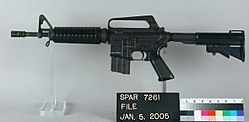| Model | Image | Caliber | Type | Origin | Details |
|---|
| Boys Anti-tank Rifle |  | .55 Boys | Anti-tank rifle |  United Kingdom United Kingdom | Two examples [25] recovered, one in Belfast in late 1971 [108] and another in Derry following Operation Motorman in 1972. [109] Derry rifle linked to attack on British Army Saracen APC. [25] .55 rounds found in hidden IRA arms dump in County Donegal in early 1974. [110] |
| Solothurn S-18/1000 |  | 20×138mmB | Anti-tank rifle |  Switzerland Switzerland | In August 1971 the search of a farmhouse outside Cookstown, County Tyrone, by the British Army and RUC uncovered IRA training literature, including a manual for a "Solothurn 20mm anti-tank rifle." [111] IRA unit employed a Solothurn 20mm anti-tank rifle in a battle with the British Army along the County Louth border in January 1972, later captured by Gardaí. [112] Solothurn S-18/1000 seized at New York home of IRA gun runner George Harrison in June 1981. [106] [113] Crate of 20×138mmB Solothurn ammunition found in IRA arms dump outside Kildare in 1990. [79] |
| M20 "Super Bazooka" |  | 3.5 in (88.9 mm) | Rocket launcher |  United States United States | Several imported from the United States in the late 1950s but first employed by the IRA in late 1971, in Belfast. Supplanted by the RPG-7. [5] [114] [115] |
| RPG-7 |  | 40mm (launcher only, warhead diameter varies) | Rocket-propelled grenade |  Soviet Union Soviet Union
 Libya Libya | 25 launchers and 496 warheads smuggled to Ireland from Libya in late 1972 [116] and further shipments from Libya in 1985-1987. Attempted import from Lebanon intercepted in Antwerp in 1977. [20] First used in 1972, with nearly two hundred attacks involving the RPG-7 recorded by 1981. [117] The IRA was believed to still have upwards of 40 launchers in inventory in 1992. [90] |
| Pansarvärnsgevär m/42 |  | 20×180mm R | Recoilless rifle/Anti-tank rifle |  Sweden Sweden | Fired on at least three occasions in Belfast in 1983. [118] [119] Example discovered in an IRA arms dump in County Cavan in March 1988. [120] |
| M40 recoilless rifle |  | 105mm | Recoilless rifle |  United States United States | Several seized during the capture of Libyan arms aboard the freighter Eksund in 1987. [121] [72] [103] |
| Improvised Anti-Armour Grenade (IAAG) or ‘drogue bomb’ | | Unknown | Anti-tank grenade |  Ireland Ireland | Anti-armour grenade manufactured by the IRA. First appeared in late 1987. Design resembled a WW1-era German hand grenade, with a tin can filled with Semtex with a handle and a parachute device. Parachute ensured a copper cone attached to the top was the first point of contact, facilitating a shaped charge effect. [74] [122] [123] |
| Projected Recoilless Improvised Grenade | | unknown, 1-pound (0.45 kg) tin can filled with 600g of Semtex formed into a shaped charge | Improvised launcher |  Ireland Ireland | First appeared in 1991. Design, including a counter-balance mechanism, believed to have been inspired by the Armbrust launcher. [107] |
| Raufoss Mk 211 |  | .50 BMG | Multi-purpose armor-piercing projectile |  United States United States | Several smuggled from the United States in the late 1990s. [59] |





































































